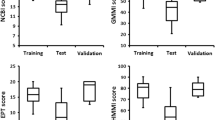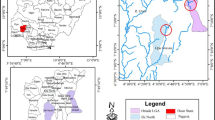Abstract
Attempting to help reduce the costs of bioassessment of aquatic habitats, the aim of this study was to estimate how particular substrate types influence the ecological quality evaluation based on a multihabitat scheme proposed by the AQEM/STAR consortium. Samples of macroinvertebrates were taken from the Stupavský potok brook, a small, 4th order calcareous stream in the Small Carpathians in Slovakia (Central Europe). Eight most suitable metrics for small Slovakian streams forming the Slovak multimetric index on seven substrate types were tested and compared with the multihabitat sample. The Saprobic Index (SI) and Index of Biocenotic Region (IBR) showed considerably worse (higher) values in the psammal and the best (lowest) values on coarse mineral substrates (lithal, akal). Similarly, values of the metrics Oligo (%), BMWP Score, Rheoindex, Rhithron Typie Index (%) and EPT reached their worst (lowest) values on psammal and the best (highest) values on coarse mineral substrates. Psammal sample showed the worst ecological quality expressed by the lowest EQR (Ecological Quality Ratio) value, most significantly differing from the multihabitat sample (Multiple Comparisons of Means: Dunnett Contrasts: −8.25, P < 0.01). We conclude that substrate types considerably influence selected metrics. Because of a relatively substantial proportion of psammal in some small Slovakian streams and its marginal influence on the overall ecological quality of the site, we suggest conduct further research addressing the effectiveness of its usage in the water management.
Similar content being viewed by others
Abbreviations
- SI:
-
Saprobic Index (Zelinka and Marvan)
- Oligo (%):
-
proportion of individuals with a preference for oligo-saprobic conditions (scored taxa = 100%)
- BMWP:
-
Biological Monitoring Working Party
- RTI:
-
Rhithron Typie Index
- IBCR:
-
Index of Biocoenotic Region
- Aka+Lit+Psa (%):
-
proportion of individuals with a preference for gravel, lithal and sand (scored taxa = 100%)
- EPT:
-
number of Ephemeroptera, Plecoptera and Trichoptera taxa, Rheoindex -Banning, with abundance classes. Term “scored taxa = 100%” means that only taxa for which autecological information was available were included in the metric calculation.
References
Anonymous 2003. Monitoring under the Water Framework Directive. Common Implementation Strategy for the Water Framework Directive (2000/60/EC) Guidance Document No. 7, Produced by Working Group 2.7 — Monitoring, Office for Official Publications of the European Communities, Luxemburg, 153 pp. ISBN: 92-894-5127-0
AQEM Consortium 2002. Manual for the Application of the AQEM System. A Comprehensive Method to Assess European Streams Using Benthic Macroinvertebrates, Developed for the Purpose of the Water Framework Directive. Version 1.0, February 2002, 202 pp.
Barbour M.T., Gerritsen J., Snyder B.D. & Stribling J.B. 1999. Rapid bioassessment protocols for use in streams and wadeable rivers: Periphyton, benthic macroinvertebrates and fish. Second Ed. EPA 841-B-99-002. U.S. Environmental Protection Agency, Office of Water, Washington, D.C., 339 pp.
Brabec K., Zahrádková S., Němejcová D., Pařil P., Kokeš J. & Jarkovský J. 2004. Assessment of organic pollution effect considering differences between lotic and lentic stream habitats. Hydrobiologia 516: 331–346. DOI: https://doi.org/10.1023/B:HYDR.0000025274.47757.85
Brown A.V. & Brussock P.P. 1991. Comparisons of benthic invertebrates between riffles and pools. Hydrobiologia 220: 99–108. DOI: https://doi.org/10.1007/BF00006542
Buffagni A., Erba S., Cazzola M. & Kemp J.L. 2004. The AQEM multimetric system for the southern Italian Apennines: assessing the impact of water quality and habitat degradation on pool macroinvertebrates in Mediterranean rivers. Hydrobiologia 516: 313–329. DOI: https://doi.org/10.1023/B:HYDR.0000025273.15958.6a
Buffagni A., Kemp J.L., Erba S., Belfiore C., Hering D. & Moog O. 2001. A Europe-wide system for assessing the quality of rivers using macroinvertebrates: the AQEM Project and its importance for southern Europe (with special emphasis on Italy). J. Limnol. 60 (suppl. 1): 39–48. DOI: https://doi.org/10.4081/jlim-nol.2001.s1.39
Dallas H.F. 2007. The influence of biotope availability on macroinvertebrate assemblages in South African rivers: implications for aquatic bioassessment. Freshwater Biol. 52 (2): 370–380. DOI: https://doi.org/10.1111/j.1365-2427.2006.01684.x
Derka T., Kováčová J. & Bulánková E. 2001. Substrate importance for selected macrozoobenthic communities in Rudava river. Folia Faunistica Slovaca 6: 59–68.
Dudley T. 1988. The role of plant complexity and epiphyton in colonizaton of macrophytes by stream insects. Verh. Int. Verein. Limnol. 23: 1153–1158.
European Commision 2000, Directive 2000/60/EC of the European Parliament and of the Council of 23 October 2000 Establishing a Framework for Community Action in the Field of Water Policy, Official Journal of the European Communities. L237, Vol. 43: 1–71, European Commission, Brussels.
Frontier S. 1985. Diversity and structure in aquatic ecosystems, pp. 253–312. In: Barnes H., Barnes M. (eds), Oceanogr. Mar. Biol. Annu. Rev. Vol. 23, Aberdeen University Press, Aberdeen, 590 pp. ISBN: 9781482267259
Gavlasová S. & Derka T. 2004. Význam submerzných koreňov pobrežných drevín pre spoločenstvá makrozoobentosu rieky Jelešňa [The importance of submerged roots of riparian trees for the macroinvertebrate communities of the Jelešňa River]. Acta Facultatis Ecologiae, Fakulta ekológie a environmentalistiky Technickej univerzity Zvolen 12: 65–72.
Godfrey P.J. 2003. A review of the invertebrate interest of coarse woody debris in England. English Nature Research Reports, Number 513. Northminster House, Peterborough, UK, 51 pp.
Gregory M.B. 2005. Microhabitat preferences by aquatic invertebrates influence bioassessment metrics in Piedmont streams of Georgia and Alabama. In: Hatcher K.J. (ed.), Proceedings of the 2005 Georgia Water Resources Conference, April 25–27, 2005, University of Georgia. https://doi.org/water.usgs.gov/nawqa/urban/pdf/GWRC05_Gregory.pdfnawqa/urban/pdf/GWRC05_Gregory.pdf (accessed 01.12. 2016)
Gregory S.V., Swanson F.J., McKee W.A. & Cummins K.W. 1991. An ecosystem perspective of riparian zones. Bioscience 41: 540–551.
Harrod J.J. 1964. The distribution of invertebrates on submersed aquatic plants in a chalk stream. J. Anim. Ecology 33: 335–348. DOI: https://doi.org/10.2307/2634
Hering D., Kail J., Eckert S., Gerhard M., Meyer E.I., Mutz M., Reich M. & Weiß I. 2000. Coarse woody debris quantity and distribution in Central European streams. Int. Rev. Hydrobiol. 85: 5–23. DOI: https://doi.org/10.1002/(SICI)1522-2632(200003)85:1<5::AID-IROH5>3.0.CO;2-X
Hoffmann A. 2000. The association of the stream caddisfly Lasiocephala basalis (Kol) (Trichoptera: Lepidostomatidae) with wood. Int. Rev. Hydrobiol. 85: 79–93. DOI: https://doi.org/10.1002/(SICI)1522-2632(200003)85:1<79::AID-IROH79>3.0.CO;2-U
Hoffmann A. & Hering D. 2000. Wood-associated macroinvertebrate fauna in Central European streams. Int. Rev. Hydrobiol. 85: 25–48. DOI: https://doi.org/10.1002/(SICI)1522-2632(200003)85:1<25::AID-IROH25>3.0.CO;2-R
Jähnig S.C. & Lorenz A.W. 2008. Substrate-specific macroin-vertebrate diversity patterns following stream restoration. Aquat. Sci. 70: 292–303. DOI: https://doi.org/10.1007/s00027-008-8042-0
Jensen K. & Madsen T. 1989. Invertebrate graze submersed rooted macrophytes in lowland streams. Oikos 55: 421–423.
Jowett I.G. & Richardson J. 1990. Microhabitat preferences of benthic invertebrates in a New Zealand river and the development of in-stream flow-habitat models for Deleatidium spp., New Zeal. J. Mar. Fresh. 24: 19–30. DOI: https://doi.org/10.1080/00288330.1990.9516399
Jowett I.G., Richardson J., Biggs B.J.F., Hickey C.W. & Quinn J.M. 1991. Microhabitat preferences of benthic invertebrates and the development of generalised Deleatidium spp. habitat suitability curves, applied to 4 New-Zealand rivers, New Zeal. J. Mar. Fresh. 25: 187–199. DOI: https://doi.org/10.1080/00288330.1991.9516470
Korsu K. 2004. Response of benthic invertebrates to disturbance from stream restoration: the importance of bryophytes. Hydrobiologia 523: 37–45. DOI: https://doi.org/10.1023/B:HYDR.0000033086.09499.86
Kubosova K., Brabec K., Jarkovsky J. & Syrovatka, V. 2010. Selection of indicative taxa for river habitats: a case study on benthic macroinvertebrates using indicator species analysis and the random forest methods. Hydrobiologia 651: 101–114. DOI: https://doi.org/10.1007/s10750-010-0280-1
Lenat D.R. & Penrose D.P. 1996. History of the EPT taxa richness metric. Bull. N. Am. Benthol. Soc. 13: 305–306.
Lindegaard C. & Thorup J. 1975. The invertebrate fauna of the moss carpet in the Danish spring Ravnkilde and its seasonal, vertical, and horizontal distribution. Arch. Hydrobiol. 75: 109–139.
Logan P. & Brooker M.P. 1983. The macroinvertebrate faunas of riffles and pools. Wat. Res. 17: 263–270. DOI: https://doi.org/10.1016/0043-1354(83)90179-3
Louhi P., Mykrä H., Paavola R., Huusko A., Vehanen T., Mäki-Petäys A. & Muotka T. 2011. Twenty years of stream restoration in Finland: little response by benthic macroinvertebrate communities. Ecol. Appl. 21: 1950–1961. DOI: https://doi.org/10.1890/10-0591.1
McElhone M.C. & Davies R.W. 1983. The influence of rock surface area on the microdistribution and sampling of attached riffle dwelling Trichoptera in Hartley Creek, Alberta. Can. J. Zool. 61: 2300–2304. DOI: https://doi.org/10.1139/z83-302
Mutz M. 2000. Influence of woody debris on flow patterns and channel morphology in a low energy, sand-bed stream reach. Int. Rev. Hydrobiol. 85: 107–121. DOI: https://doi.org/10.1002/(SICI)1522-2632(200003)85:1<107::AID-IROH107>3.0.CO;2-L
O’Connor N.A. 1992. Quantification of submerged wood in lowland Australian stream system. Freshwater Biol. 27: 387–395. DOI: https://doi.org/10.1111/j.1365-2427.1992.tb00548.x
Payne R., Murray D., Harding S., Baird D. & Soutar D. 2009. GenStat for Windows, 12th Edition Introduction. VSN International Ltd: Hemel Hempstead, UK, 256 pp.
Schröder M., Kiesel J., Schattmann A., Jahnige S.C., Lorenz A.W., Kramm S., Keizer-Vlek H., Rolauffs P., Graf W., Leitner P. & Hering D. 2013. Substratum associations of benthic invertebrates in lowland and mountain streams. Ecol. Indic. 30: 178–189. DOI: https://doi.org/10.1016/j.ecolind.2013.02.012
Skuja A. 2011. Microhabitat preference of caddisfly (Trichoptera) communities in a mediumsized lowland stream in Latvia. Zoosymposia 5: 425–433. DOI: https://doi.org/10.11646/zoosymposia.5.1.36
Springe G., Sandin L., Briede A. & Skuja A. 2006. Biological quality metrics: their variability and appropriate scale for assessing streams. Hydrobiologia 566 (1): 153–172. DOI: https://doi.org/10.1007/s10750-006-0099-y
Šporka F., Pastuchová Z., Hamerlík L., Dobiašová M. & Beracko P. 2009. Assessment of running waters (Slovakia) using benthic macroinvertebrates derivation of ecological quality classes with respect to altitudinal gradients. Biologia 64: 1196–1205. DOI: https://doi.org/10.2478/s11756-009-0201-9
Šporka F., Vlek H.E., Bulánková E. & Krno I. 2006. Influence of seasonal variation on bioassessment of streams using macroinvertebrates, pp. 543–555. DOI: https://doi.org/10.1007/978-1-4020-5493-8_36. In: Furse M.T., Hering D.K., Vrabec K., Buffagni A., Sandin L. & Verdonschot P.F.M. (eds), The Ecological Status of European Rivers: Evaluation and Intercalibration of Assessment Methods, Hydrobiologia 566 Series title: Developments in Hydrobiology Vol. 188, Springer Netherlands, 555 pp. ISBN: 978-1-4020-5160-9
Vandewalle M., de Bello F., Berg M.P., Bolger T., Dolédec S., Dubs F., Feld C.K., Harrington R., Harrison P.A., Lavorel S., da Silva P.M,. Moretti M., Niemelä J., Santos P., Sattler T., Sousa J.P., Sykes M.T., Vanbergen A.J. & Woodcock B.A. 2010. Functional traits as indicators of biodiversity response to land use changes across ecosystems and organisms. Biodivers. Conserv. 19: 2921–2947. DOI: https://doi.org/10.1007/s10531-010-9798-9
Verdonschot R.C.M., Kail J., McKie B.G. & Verdonschot P.F.M. 2016. The role of benthic microhabitats in determining the effects of hydromorphological river restoration on macroin-vertebrates. Hydrobiologia 769: 55–66. DOI: https://doi.org/10.1007/s10750-015-2575-8
Warmke S. & Hering D. 2000. Composition, microdistribution and food of the macroinvertebrate fauna inhabiting wood in low-order mountain streams in Central Europe. Int. Rev. Hydrobiol. 85: 67–78. DOI: https://doi.org/10.1002/(SICI)1522-2632(200003)85:1<67::AID-IROH67>3.0.CO;2-7
Williams D.D. 1980. Some relationships between stream benthos and substrate heterogenity. Limnol. Oceanogr. 25: 166–172. DOI: https://doi.org/10.4319/lo.1980.25.1.0166
Wood P. 1998. Reach-scale mesohabitat variations in a small chalk stream under low flow conditions, pp. 31–38. In: Bretschko G. & Helešic J. (eds), Advances in River Bottom Ecology, Backhuys Publishers, Leiden, the Netherlands, 344 pp. ISBN: 9073348870
Yamamuro A.M. & Lamberti G.A. 2007. Influence of organic matter on invertebrate colonization of sand substrata in a northern Michigan stream. J. North Am. Benthol. Soc. 26: 244–252. DOI: https://doi.org/10.1899/0887-3593(2007)26[244:IOOMOI]2.0.CO;2
Author information
Authors and Affiliations
Corresponding author
Rights and permissions
About this article
Cite this article
Kalaninová, D., Krno, I., Hamerlík, L. et al. Bioassessment of streams based on macroinvertebrates — can sampling of some substrate types be excluded?. Biologia 72, 431–444 (2017). https://doi.org/10.1515/biolog-2017-0049
Received:
Accepted:
Published:
Issue Date:
DOI: https://doi.org/10.1515/biolog-2017-0049




